The largest academy trusts have low numbers of schools rated at least good by Ofsted, with most operating more ‘not-good’ schools than good and outstanding ones – analysis by Schools Week shows.
Of the five chains with the most schools, none has more than 65 per cent of its academies rated as either good or outstanding, with all bar one below 50 per cent.
The proportion of schools given a good or outstanding rating across the country is 81 per cent, the government said recently.
The five biggest academy chains are: Academies Enterprise Trust (AET), School Partnership Trust Academies (SPTA), Oasis Community Learning, the Kemnal Academy Trust (TKAT) and United Learning. Each has at least 40 schools.
Asked about their performance, the trusts all said that they had taken over a disproportionate number of schools rated less than good. However, only those schools which have had a full inspection since the chain took over were counted in our analysis.
Other academy trusts have also taken over large numbers of poorly performing schools and yet have had greater success in turning them around.
The Harris Federation has 35 open primary and secondary academies. Of the 18 schools that have been inspected since they opened or converted to academy status, 17 (94 per cent) received either a good or outstanding rating. The trust said that in the 16 cases where there had been a predecessor school, 15 had been rated less than good.
Meanwhile ARK has 17 schools that have been inspected since the trust has had responsibility for them, with 15 (88 per cent) achieving one of the top two inspection grades. The trust said that, of the 10 schools which transferred to it, only two had then been rated at least good.
The analysis is likely to reignite the debate about whether Ofsted should be allowed to inspect academy chains.
Currently, it can carry out focused inspections on academies that are part of a given trust, but cannot visits the trust’s head offices or issue an overall rating.
Chief inspector Sir Michael Wilshaw has called for these powers, but to date has been rebuffed.
In a recent Education Select Committee hearing, Nicky Morgan said that Ofsted already had adequate power to inspect academy trusts via school inspections.
Ofsted has carried out focused inspections of schools in three of the biggest five chains – AET, SPTA and TKAT – and has warned about performance in all cases.
AET was also on a list of trusts restricted from sponsoring new schools, the government said in March.
A – Academies Enterprise Trust (AET)
Head office in Essex 76 open schools
The trust said: “A significant number of schools that opened as AET academies had a history of underperformance with outcomes well below national average … Of the 59 academies, 49 per cent are now judged to be ‘good’ or better by Ofsted, compared to 22 per cent prior to becoming AET academies … We expect two-thirds of our academies are judged to be good or better by July 2015.”
B – School Partnership Trust Academies (SPTA)
Head office in Leeds 47 open schools
The trust said: “On conversion 83 per cent of the 26 schools included in the analysis were less than good (with 62 per cent requiring improvement and 21 per cent inadequate). This means at the point of inspection with SPTA (in most cases less than two years) there has been an increase in the proportion of good or better schools from 17 per cent to 46 per cent.”
C – Oasis Community Learning
Head office in London 43 open schools
The trust said: “Out of our 10 inspected schools that are rated good or outstanding, eight entered the Oasis family with an ‘inadequate’ or ‘requires improvement’ judgment. Of the 11 inspected schools that are judged to require improvement, six have been lifted out of a category of concern since their time with Oasis and a further four who retain an RI judgment have only been with us for two years or less.”
D – The Kemnal Academy Trust (TKAT)
Head office in Kent 40 open schools
The trust said: “Although the figure sits at 62 per cent rated less than good it is a 25 percentage point improvement from prior to TKAT taking over the schools as they were at 87 per cent less than good. It is TKAT’s policy to take on schools at all performance levels. … Our commitment is to support every school to educational excellence. This process cannot happen overnight …”
E – United Learning
Head office in Peterborough 40 open schools
The trust said that, of the 20 academies that have had section 5 inspections since coming under its responsibility, 19 were rated less than good before it took them over. Since then, only seven have received ratings less than good.
*Source: Ofsted website, November 7. Only those section 5 inspections which have been carried out since the trust took responsibility for the schools are counted. Percentages may not sum to 100 due to rounding.




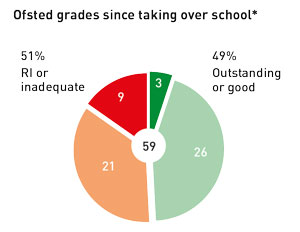

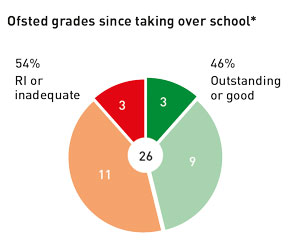

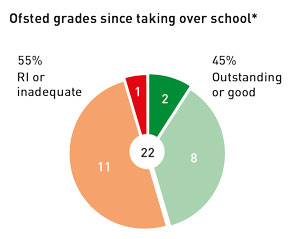
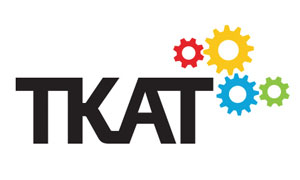
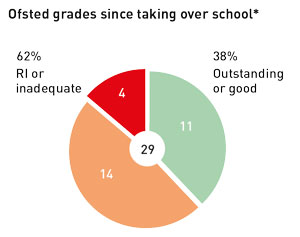

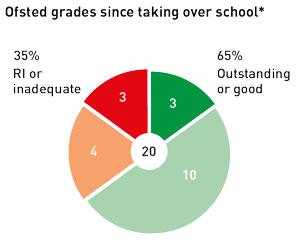






Here’s some more information:
AET – twice censured by Ofsted for poor performance. EFA has told AET to sort out its finances amid concerns about ‘volatility’.
TKAT: TKAT removed two-thirds of its heads when it took over schools. Ofsted focused inspections: 66% of TKAT academies inspected since being sponsored remain ‘less than good’. Two TKAT academies recently downgraded from the Good judgements given prior to TKAT taking over.
Oasis Community Learning: Increased use of equivalent exams significantly in 2013.
SPTA: Ofsted focused inspections: inspectors found ‘key weaknesses’ in several of the academies. SPTA caused controversy when it appeared it was advertising for unqualified maths teachers with a minimum of 4
GCSEs. The Trust claimed it had been published in error.
United Learning: DfE sent out pre-warning letters to two of its academies in Autumn 2012. In March 2014, ULT had a row with DfE about alleged over-estimation of pupil numbers.
I believe that Oasis actually has 51/52 schools now